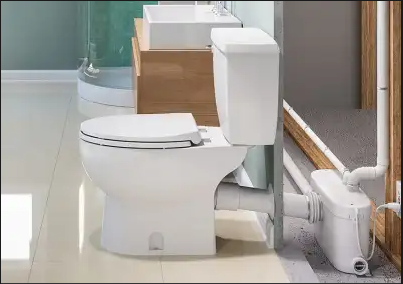If you are installing a toilet in your basement as an afterthought, you should strive to install it without breaking concrete. Doing so requires you to have sufficient skills to make the process seamless. If you do not possess the skills to pull it off, it would be advisable to seek professional plumber services. This guide explains how to install a toilet in the basement without breaking concrete or setting up a complex plumbing system.
Upflush toilets are a great choice if you want to install your toilet in the basement without breaking concrete. Note that upflush toilets come in different shapes and sizes but generally incorporate a pumping system.
Why An Upflush Toilet is Ideal for Your Basement
An upflush system is the best toilet for installing in your basement without breaking concrete. It is worth noting that an upflush commode prevents you from damaging precast concrete. Moreover, a macerating toilet allows you to put in additional features.
An upflush toilet is suitable for basements because it does not rely on gravity for drainage. The commode has a pump that pumps wastewater from the basement to the sewer system at ground level. Most upflush toilets also give you value for money, courtesy of their exceptionally long lifespans.
What Skills Should You Have?
If you want to install a toilet in your basement without breaking concrete successfully, you must have some basic skills. They include:
- Plumbing skills
- Electrical skills
- Framing skills
- Finish carpentry skills
- Painting skills
Requisite Tools and Materials
Installing a commode in your basement without breaking concrete can be a walk in the park if you have the right tools and materials. Some of the items you require include:
- Tape measure
- Dust Mask
- Electric hammer drill
- Safety glasses
- Shovel
- Chalk Line
- Level
- Water hose
- Pipe wrench
- Two-part epoxy
How to Install Your Commode in the Basement without Damaging Concrete
Once you have all the tools and materials for the work, here are the steps to follow:
Step One: Prepare Your Working Space
Installing your toilet requires you to have ample working space. It would be best to prepare your working area by getting rid of furniture and stray objects that can impede the installation process. Remember to clear out dirt so that any markings you make on the installation area are visible.
Step Two: Disconnect Drainage and Turn Off the Bathroom Water Supply
You can turn off the bathroom water supply by shutting off the water valve that controls water flowing into the bathroom. Next, disconnect the bathroom’s drainage. If you do not know where the valves are located, you can ask the plumber who did the plumbing in your house. You can disconnect the bathroom’s drainage by unscrewing the connecting nut.
Step Three: Remove the Old Toilet
The third step entails removing the old commode from the basement. If your basement bathroom floor is made of wood, you should employ a plunger to lift the commode off of its flange. If the basement is made of concrete, you should use an electric hammer drill to disintegrate the concrete before taking out the flange.
Step Four: Ensure That the Basement Floor is Level
After removing the old toilet, the next step is to ensure the basement floor is level. You can use a level to assess the smoothness and evenness of the basement floor. If the basement floor is uneven, you can even it out using a masonry bit.
Step Five: Install the Toilet Flange
After straitening the bathroom floor, you can then install the toilet flange. Note that new flanges often include screws for attaching the flange to the basement floor. If the existing flange is uncompromised, you can still use it. Ideally, it would be best to use a plumber’s putty to attach the flange to your toilet base. Ensure that your flange is aligned before fastening it.
Step Six: Connect Drainage
This step involves connecting the toilet to the basement’s drainage lines. It is advisable to read the toilet’s installation manual before linking the drainage. You can procure the services of a professional plumber if you find the process too complicated. You can also connect the household’s water supply line to the cistern at this stage. A pipe wrench should come in handy.
Step Seven: Install the Commode Seat
You can then install the commode seat after connecting your toilet to the basement’s water supply line. Most commodes have an installation manual that guides you on how to go about the process. At this stage, you can also install the toilet cover. Notably, the installation process for the cover is pretty straightforward.
Step Eight: Test for Leakages
Turn the main water supply valve and wait for the cistern to fill up. After that, flush the commode at least two times. If there are no leakages on any joints, the toilet is ready for use. If you notice any leakages, turn off the bathroom’s water supply and make repairs. Repeat the process until there are no leakages left.
Step Nine: Put Final Touches on Your Toilet
This step is purely optional. After installation and testing, you can choose to put final touches on your commode for aesthetic purposes. For instance, you can paint the caulk used at the toilet base to achieve uniformity. Additionally, you can add a rug to the area below the toilet bowl for optimal user comfort. Installing a novel toilet in the basement is quite simple if you follow these steps. All you need is the expertise, tools, and materials to execute each step flawlessly.

Factors to Consider When Installing Your Toilet in the Basement
Before installing your commode in the basement, you should consider several factors. They include:
Building Regulations and Permits
If you have ever implemented a remodeling or renovation project in the past, you probably know that you must adhere to building regulations in your area. Well, installing a commode in the basement is no different. Failing to adhere to building codes can lead to fines or even project cancellations. You must also obtain a permit from relevant authorities before proceeding with your toilet installation project.
You need to prove the project’s safety to authorities before receiving a permit. Pertinent building codes predominantly relate to bathroom spacing. It is worth noting that bathrooms constructed in the basement are ordinarily compact and space matters a lot. International building codes require basement bathrooms to have a floor-to-ceiling measurement of at least 6 feet.
International building codes also outline spacing specifications around commodes. The minimum distance between the sink and the commode should be 21 inches. Additionally, the minimum space between your toilet and any wall should be 25 inches.
When installing a toilet in your bathroom, you must also consider venting requirements set out in international building codes. Basement bathrooms should have either a vent on the ceiling or a window measuring approximately 3 ft2. Notably, the ceiling vent should be capable of moving 50 ft3 of air every minute.
Plumbing Lines
You should consider existing plumbing lines before installing a toilet in the basement. Ideally, it would be best to put up your commode below a first-floor bathroom. Doing so will enable you to capitalize on extant plumbing lines and ultimately save costs.
Lighting
Basement bathrooms are quintessentially dark spaces because they do not have windows. Therefore, you should consider how to light the room before installing your toilet. You must know that the basement’s ceiling height directly impacts your lighting options.
The ceiling height of basement bathrooms is ordinarily smaller than that in first-floor bathrooms. For instance, a 7-foot ceiling height limits your lighting choices to a thinner subset. Notably, wall-mounted sconces and recessed fixtures are ideal for a basement bathroom whose ceiling height is less than 7 feet. Higher ceilings broaden your lighting options to include elegant chandeliers and dome lights.
Plumbing Depth
When installing a toilet in your bathroom without breaking concrete, you must consider the depth of drainage lines in your basement. Ideally, existing drainage lines should have a sloping gradient to allow gravity to carry away solid waste. Most homes have a deep primary home drain that can quickly drain waste from the basement bathroom.
If the main drainage in your home is not deep enough to allow for gravity-induced waste flow, you need not worry. You can remodel the drainage system in your home to take it to an ideal drainage depth. Alternatively, you can install an upflush toilet that does not rely on gravity to get rid of solid waste.
Bottom Line
With the right skills, materials, and tools, you can easily install a commode in your basement without breaking concrete. Some of the tools you require include masonry bits, pipe wrenches, shovels, safety glasses, water hoses, etc. Additionally, it would help to consider the ceiling height, building codes, lighting, plumbing depth, and plumbing lines when planning to install a toilet in the bathroom. An uplush toilet is ideal for your basement bathroom since it does not depend on gravity to get rid of solid and liquid waste.

Judy Battista is an interior designer who holds a bachelor’s degree in interior design from Cornell University — Ithaca, NY. Her passion for home improvement and interior design has contributed to her extensive knowledge of everything bathroom remodeling and general interior design. Judy often publishes home décor articles on several websites, including Sprucetoilets.com, Sprucebathroom.com, and Mybesuitedhome.com. She also contributes to various interior design magazines. As a skilled interior designer, Judy Battista is well versed in computer-aided design (CAD) and other technologies used in the interior design space.
